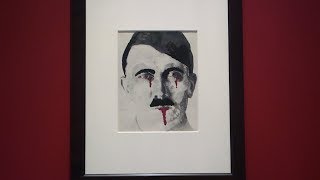(单词翻译:单击)
听力文本
Hari Sreenivasan: We turn now to an art exhibit here in New York city that examines the relationship between the rise of nationalism and censorship of the arts. NewsHour weekend's Ivette Feliciano reports.
Ivette Feliciano: Countries from Poland to Hungary to Turkey are experiencing a rise in nationalism and the effects it can have on free speech. While this turmoil goes on, a new exhibit at New York's Neue Galerie, "Before the Fall," examines art produced in Germany and Austria under the Third Reich and what can happen to a culture when free speech is curtailed in the extreme.
Dr. Olaf Peters, Art historian, Germany's Martin Luther University: The idea behind the exhibition is to think about how artists reacted to political, historical circumstances and how they work, evolve during the 1930s. So, it was really like thinking about, is there potential in art to reflect on historical circumstances?
Ivette Feliciano: Dr. Olaf Peters is an art historian at Germany's Martin Luther University and the exhibit's curator. The show is a continuation of two previous Neue shows. "Degenerate Art" examined works that the Nazi party publicly denigrated while "Berlin Metropolis" looked at the rich artistic culture of Germany's capital in the 1920s.
Adolf Hitler's Third Reich purged the modern art world after coming to power in 1933. It raided the influential Bauhaus art school and shut it down. It did the same to the modern art wing of the German National Gallery. Hitler banned many artists from creating art altogether.
Dr. Olaf Peters: You had an extremely strong and rich art scene during the 1920s in Germany. For me, the question was always, what happened to this art scene?
Ivette Feliciano: Peters says that many artists camouflaged their beliefs using conventional art forms. Still lifes and portraits became heavy with symbolism. Landscapes, like the 1936 painting "Expectation" by German artist Richard Oelze, depicted dark and foreboding scenes.
Dr. Olaf Peters: It's a little bit apocalyptic landscape on the one side if you have, on the other side, a group of people standing there and looking maybe into a dark or unknown future.
Ivette Feliciano: Those artists who did not conform could not find a safe venue for their work. How was their work received at the time by the public?
Dr. Olaf Peters: Some are so overt when it comes to critique of those circumstances, the living conditions of the Third Reich, that it's impossible to show them.
Ivette Feliciano: One artist who chose self-exile was the German painter Max Beckmann, who left Germany for the Netherlands in 1937. There he painted a work called "Birds' Hell," which contains political references to the Nazi party.
Dr. Olaf Peters: It was painted one year after Max Beckmann had left Germany. And in Amsterdam, he made the decision to create this allegory of his country where you can see the birds torturing, for example, saluting.
Ivette Feliciano: Some artists paid the ultimate price for their work. One was a Jewish-Austrian artist named Friedl Dicker-Brandeis.
Dr. Olaf Peters: She was highly political. She studied at the Bauhaus in Weimar in Germany, went back to Austria and developed some, say, political montages or collages in the early 1930s. But she was captured. She depicted some interrogations which are really touching because you can see what torture meant. And she was finally brought into an extermination camp and was killed.
Ivette Feliciano: Dr. Peters says that visitors to the exhibit may view these older works in a new light, following a recent nationalist surge in europe.
Dr. Olaf Peters: The situations are different, and history is not repeating itself. But, of course, you have to learn from history, maybe think about how to avoid developments which are not a little bit similar, not identical, and, yeah, and be aware of your responsibility.
重点解析
1.in the extreme 极端
Their communication systems are inefficient in the extreme.
他们的通讯系统效率非常差。
2.react to 对…作出反应
Someone allergic to milk is likely to react to cheese
对牛奶过敏的人可能对奶酪也有不良反应。
3.shut down 关闭
Smaller contractors had been forced to shut down...
规模较小的承包商已被迫歇业。
4.heavy with 充满
The air is heavy with moisture.
空气的湿度很大。
5.at the time 当时
I was not in Britain at the time
当时我不在英国。
参考译文
哈里·斯雷尼瓦桑:现在我们将目光转向纽约,这里正在举办一个艺术展览,透过这个展览,人们可以了解民族主义的兴起与艺术审查制度之间的关系。NewsHour周末记者伊维特·费利西亚诺报道。
伊维特·费利西亚诺:从波兰到匈牙利再到土耳其,这些国家正感受着民族主义的兴起,以及它对言论自由的影响。正当一切方兴未艾,新展览《Before the Fall》在纽约新艺廊德奥艺术美术馆开幕,其中展出的艺术品为第三帝国时期的德国人及奥地利人所作,那时言论自由遭到极端剥夺,本次展览带我们领略了当时的文化背景。
奥拉夫·彼得斯博士,德国马丁·路德大学艺术历史学家:本次展览的初衷在于引发人们思考在20世纪30年代,艺术家如何应对政治,如何应对历史环境,他们又如何展开工作。所以,这当真是在思考,艺术有没有可能反映历史环境?
伊维特·费利西亚诺:奥拉夫·彼得斯博士是德国马丁·路德大学的艺术历史学家,也是本次展览的策展人。本次展览是过去两个新艺廊德奥艺术美术馆展览的延伸。《Degenerate Art》审视了纳粹党公开贬低的作品,而《Berlin Metropolis》则对20世纪20年代德国首都的丰富艺术文化进行了探究。
阿道夫·希特勒的第三帝国在其1933年执政后,对现代艺术世界进行了清洗。当时包豪斯艺术学校极具影响,而希特勒对其突袭,将其关闭。它对德国国家美术馆同样采取了如此暴行。希特勒禁止艺术家集体创作艺术作品。
奥拉夫·彼得斯博士:20世纪20年代,德国艺术曾经何其繁荣。这个问题始终萦绕着我,这种繁荣究竟怎么了?
伊维特·费利西亚诺:彼得斯说很多艺术家用传统的艺术形式来伪装他们的信仰。静物画和肖像画都具有了浓重的象征主义色彩。很多风景画,像德国艺术家理查德·奥尔兹于1936年所创的作品《期待》,都对当时社会环境的黑暗以及对未来不详的预感进行了描绘。
奥拉夫·彼得斯博士:一方面,这有点启示性,如果你能感受到,另一方面,一群人站在那里,探入或许黑暗或未知的未来世界。
伊维特·费利西亚诺:那些不守规矩的艺术家很难找到安全的工作场地。他们当时的工作如何得到公众的接纳?
奥拉夫·彼得斯博士:许多艺术家的作品对于当时环境,第三帝国生活处境上的批判展露无遗,根本无法展出。
伊维特·费利西亚诺:德国画家马克斯·贝克曼选择了自我放逐,他于1937年离开德国前往荷兰。在那里他创作了作品《鸟的地狱》,其中提及了纳粹党。
奥拉夫·彼得斯博士:离开德国一年后,贝克曼创作了这幅作品。在阿姆斯特丹,他决定创作这个讽喻体画作,抨击他的国家,画中多个鸟型形象折磨人类,例如,致敬。
伊维特·费利西亚诺:一些艺术家为他们的作品付出了终极代价。其中一位是奥地利犹太艺术家,名叫弗利德·迪克-布朗德斯。
奥拉夫·彼得斯博士:她政治倾向极强。她在德国魏玛的包豪斯大学学习,后回到了奥地利,并与20世纪30年代早期,创作了一些,我们说,政治蒙太奇或拼贴画。但她被捕了。她的作品描绘了一些审讯过程,让人触目惊心,因为这那里,你可以看到什么才是真正的酷刑。最后她被送进了死亡集中营,惨遭杀害。
伊维特·费利西亚诺:彼得斯博士说,随着最近欧洲民族主义浪潮的涌动,参观者可以以一种新的眼光审视这些古老的作品。
奥拉夫·彼得斯博士:时过境迁,历史不会重演。但是,当然,你必须以史为鉴,思考如何避免那些类似相同的事情再度发生,是的,意识到你的责任。
译文为可可英语翻译,未经授权请勿转载!


